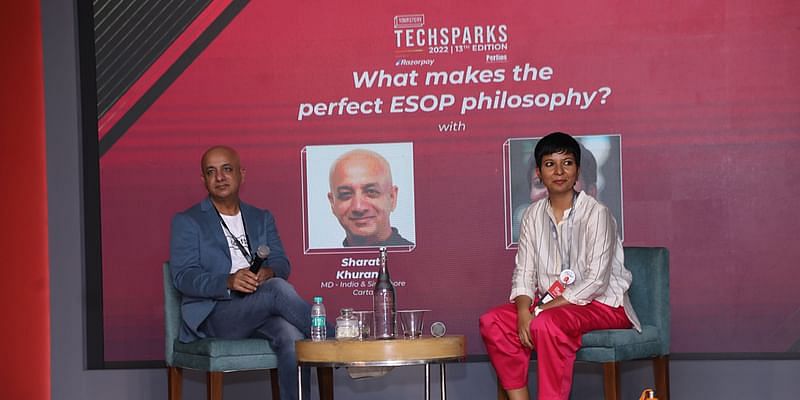As the funding winter presents a possible decline in available funding for Indian startups, the ecosystem has also been struggling to hire and retain top talent. Thus, startups have adopted methods to ensure employee rewards and retention in companies, one of which has been the establishment of ESOPs (employment stock ownership plans).
However, according to a report by Siason Capital, 2 out of 5 startups do not have an ESOP programme, and a significant portion of the surveyed companies lacked knowledge and clarity about ESOPs.
How can companies create the perfect ESOP programme that will benefit them and their employees? Sharat Khurana, MD – India & Singapore, Carta shared his thoughts with Ipsita Basu, Director – Content, Brand Communications, YourStory, in a fireside chat at TechSparks 2022.
Carta’s purpose and operations
Carta’s core purpose, Sharat said, is to create more owners. “What that means is, team members, advisors, and investors who contribute to the growth of an organisation — from the very early stages to massive liquidity events — get to participate in the outcomes that they end up contributing to,” he said, adding that Carta does everything from ESOP advisory and management to cap table management and valuations for companies right from their early days.
How ESOPs help startups
In the past, a smaller company wouldn’t have been able to keep up with large organisations and unicorns because of the lack of a big brand or their inability to match cash compensation. ESOPs can help turn that situation around and attract the right talent on board.
“Now, when an organisation is scaling, they can offer ESOPs as incentives to ensure that the team members are hitting milestones,” Sharat said, adding that ESOPs also help in retention. “I think startups can leverage equity or some form thereof across stages,” he said.
How Carta enables employees to have skin in the game
Sharat highlighted that usually, ESOP agreements are signed, filed, and forgotten, never to be revisited, as many employees forget that an ESOP is an appreciating asset.
Sharat believes that this is also where many companies fail to build an experience around it. In his opinion, it is important for companies to communicate to and make their employees understand the value of their equity and the role of dilution over time.
“Most importantly, I think it is a great opportunity for the companies to build trust with their employees,” he said, adding that this is what makes employees beholden to the company. Every one of these milestones is an opportunity to create trust with the employee, highlighted Sharat, adding that Carta works to promote this.
Learning to design the right ESOP programme
Sharat noted that companies can loop in experts if they lacked knowledge on how to create the ESOP programme that works for them. In his opinion, this must be approached with a certain discipline.
“Have a framework, identify the parameters that you value as an organisation — whether it is impact, criticality, potential, [or] softer aspects like teamwork, communication — run everybody through a consistent framework,” Sharat said, adding that these parameters can be weighted. This gives a baseline for allocating options.
He emphasised that every plan must be fair to the employees while also protecting the organisation. “Know what you don’t know and rely on experts to guide you,” he said, adding that the experts don’t need to be an organisation so long they are somebody who has seen an ESOP lifecycle and can help the company navigate it.
Transparency brought by digital platforms
Due to various incidents over the last few years, including the pandemic, companies were forced to reduce cash expenses and then used equity to make up for it. This, Sharat said, made many employers realise that this was a valuable instrument that could be used. Technology has thus played an important role in driving that visibility among employers and employees.
“The other thing that has happened – and this is really important – is that we have started seeing a lot of liquidity come into the market. So a lot of organisations, which were not historically providing liquidity, are now providing liquidity,” Sharat said, adding that this means that the trust in the instrument has gone through the roof. He highlighted that this creates a win-win situation overall for employees that obtain liquidity, founders who can prevent dilution, and investors who want greater ownership.
Managing ESOPs in the future
Sharat highlighted that platforms like Carta bring discipline into the process because all the activities are digital. Digital platforms will assimilate the documents in one place, and reduce errors and the time taken to process the grants.
“But, where I think it starts to add value is, two places: next time you are undergoing due diligence, it’s going to be an absolute breeze to go through,” he said, adding that the efficiency this delivers when scaling is second to none. From a cap table perspective, investors obtain great visibility and can see error-free transactions occur, “The resilience of every single transaction is moved to practically being foolproof,” he said, adding that that is the advantage platforms like Carta provide.











